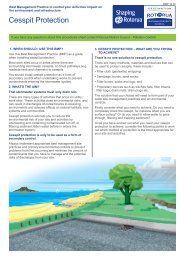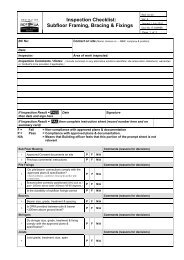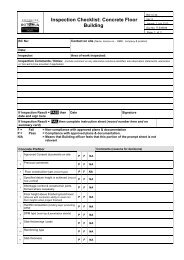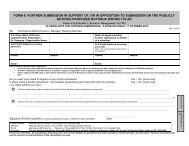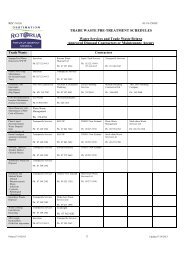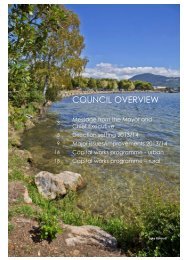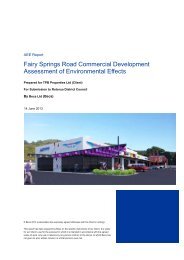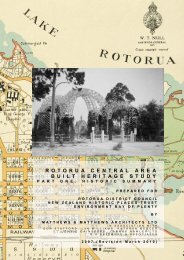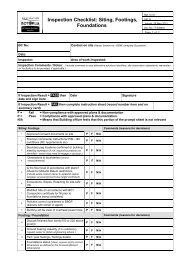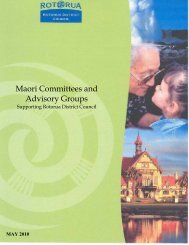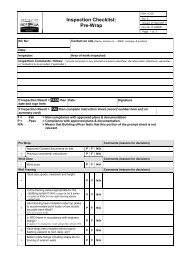Soft Soil Hazard Report - Rotorua District Council
Soft Soil Hazard Report - Rotorua District Council
Soft Soil Hazard Report - Rotorua District Council
You also want an ePaper? Increase the reach of your titles
YUMPU automatically turns print PDFs into web optimized ePapers that Google loves.
Confidential 2010<br />
Zone A:<br />
Zone B:<br />
Zone C:<br />
Zone D:<br />
Areas of volcanic-derived rocks and soils. Volcanic processes by their very<br />
nature are high-energy. No soft ground is expected in zone A as the dominant<br />
processes preclude the conditions necessary for its development.<br />
Huka Group sediments and Hinuera Formation. These sediments were formed in<br />
a range of environments. Sediments with soft and very soft strengths at the time<br />
of formation have consolidated over time and are now likely to meet the<br />
requirements for being defined as good ground as per the draft New Zealand<br />
Standard for timber framed buildings (DZ3604).<br />
Undifferentiated Holocene alluvium. Sites from a range of environmental<br />
conditions are present within this zone. Small areas of soft to very soft ground<br />
may be present as a surficial layer in some places.<br />
Sites of Holocene (last 10,000 years) swamp deposits and Holocene lake or delta<br />
sediments between the 9000 ka and modern shorelines. Four of the five<br />
documented sites of soft ground (Fitchett, 2007; Phillips, 2009; and Cowbourne<br />
2009, 2010) are located at sites mapped as Zone D.<br />
Zones A, B and C only have a little soft or very soft ground or none at all. A scala<br />
penetrometer used to depths of at least 2 m in these areas should confirm the presence or<br />
otherwise of ‘good ground’ as per the draft New Zealand Standard for timber framed<br />
buildings (DZ3604). Any soft ground will be small in extent and at the surface if present.<br />
RDC provided a number of geotechnical reports for various localities in the district. Only one<br />
of these reports identified soft ground outside of Zone D. This was a site at Lynmore<br />
(Robinson, 2004) where the soft ground was picked up using a scala penetrometer. The site<br />
is also only between 100 and 500 metres from an area mapped as Zone D.<br />
Zone D contains extensive areas of soft ground, but probably also contains areas of better<br />
ground. The soft ground site described in Phillips (2009) at Ngongotaha is located on a valley<br />
floor containing a meandering stream. The Ohinemutu site described in Cowbourne (2010) is<br />
located on the lake delta of the Ohinemutu Stream, another small meandering stream.<br />
Several other small meandering streams are present on the western and south-western<br />
shores of Lake <strong>Rotorua</strong>. On the eastern and south-eastern shores of Lake <strong>Rotorua</strong> the small<br />
streams have straighter alignments, which if natural, indicate steeper stream gradients and<br />
hence a slightly higher energy environment and thus sediment with higher strengths.<br />
Additional sites of soft to very soft ground were identified at Koutu (Cowbourne, 2009) using<br />
CPT and Te Akau Rd on the shores of Lake Rotoiti (Fitchett, 2007) using a scala<br />
penetrometer. The CPT results at Koutu cannot be compared with scala penetrometer<br />
results but do indicate that the upper two metres of had q c values between 1-2 MPa.<br />
The site at Ngongotaha has had an influx of fine to coarse sand deposited by alluvial<br />
processes over the top of lake sediments. This probably explains the slightly better scala<br />
penetrometer results for the Ngongotaha site compared to the Ohinemutu site. However, the<br />
burial by slightly stronger sediments means that a scala penetrometer lacked the depth<br />
penetration to reach the soft sediments. In Zone D a scala penetrometer can only confirm the<br />
absence of ‘good ground’ as per the draft New Zealand Standard for timber framed buildings<br />
(DZ3604). A deeper test is therefore required to establish the presence of ‘good ground’. As<br />
demonstrated at Ngongotaha and Koutu a cone penetrometer probe to at least 20 m depth<br />
GNS Science Consultancy <strong>Report</strong> 2010/81 6



